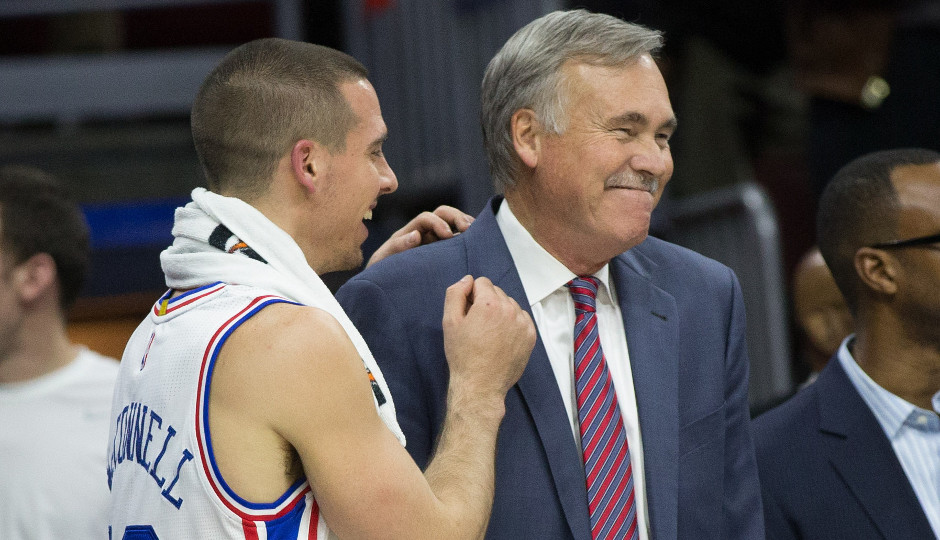T.J. McConnell’s Steady Play Providing Boost for Sixers

Sixers rookie point guard T.J. McConnell and associate head coach Mike D’Antoni react during a timeout | Bill Streicher-USA TODAY Sports
When the Sixers made the trade to acquire Ish Smith, much was made about how Smith could help elevate the play of big men Nerlens Noel and Jahlil Okafor, and deservedly so. Both of the Sixers’ prized possessions have been playing substantially better basketball with Smith’s ability to create getting them easy looks at the basket.
A secondary benefit was likely to be the Sixers’ perimeter shooters. If there’s one elite skill Smith has it’s his speed, and his ability to collapse the defense, force the opponent into help rotations, and pass out of that pressure was sure to generate more open looks for guys like Robert Covington, Hollis Thompson, and Isaiah Canaan.
One of the unexpected beneficiaries of Smith’s presence on the roster has been rookie T.J. McConnell.
It’s not that Smith has been actively helping McConnell while he’s on the court, as the pair have played in grand total of just fifteen minutes together during the twenty games since the Smith acquisition, most of which came during last week’s comeback against the Golden State Warriors. What it has done is pushed McConnell into a more appropriate role, and it’s helped elevate McConnell’s game to new heights.
Since the Smith acquisition McConnell has averaged 5.8 points, 4.4 assists, and just 1.5 turnover per game in 16 minutes per game, while assisting on 40.4 percent of the Sixers’ made field goals while he’s been on the court. Like Smith, McConnell has been extremely prudent taking care of the ball, committing turnovers on just 12.9 percent of his possessions.
The 40.4 percent assist rate is 7th in the NBA over that time.
Of the 18 rookies who have played at least 600 minutes so far this year, McConnell’s 1.5 win shares ranks 7th. He also ranks 6th in Box Plus/Minus and 6th in Value Over Replacement Player. His 37.5 percent assist rate on the season is the 3rd best assist rate for a rookie (minimum 1,000 minutes) since the start of the 2000-01 season, behind only Jamaal Tinsley (42.8 percent, 2001-02) and Chris Paul 38.2 percent, 2005-06).
Perhaps most important is the fact that the Sixers have regularly made inroads while McConnell has been on the court, with a +1.6 net rating (points scored per 100 possessions minus points allowed per 100 possessions) in the 319 minutes McConnell has played since the Smith acquisition, compared to a -8.3 net rating in the 656 minutes he’s been on the bench.
The Sixers’ offense has averaged 103.4 points per 100 possessions with McConnell on the court since the Smith trade, which is far and away the best rating among Sixers players over that span. His positive differential makes him the only player on the team in the positive since December 24th’s trade, with Jerami Grant‘s -1.8 net rating the closest.
Beyond the team’s offensive improvement, McConnell’s defensive pressure has been an important facet of his game as well.
Since December 24th the Sixers have been averaging 20.2 points per 48 minutes off of turnovers when McConnell has played, compared to just 16.2 per 48 minutes when he’s been on the bench. That has helped ignite an offense which, despite its improvement of late, can still struggle when confined to the half court.
McConnell defensive intensity has also manifested itself in how he’s defended the perimeter. The airball he forced Stephen Curry into last week drew the most attention, but McConnell has been holding his man to just 25 percent shooting on three-point attempts since December 24th, over 11 percent less than their season average from deep. That’s the sixth best differential in the league among guards who have defended at least 25 three-point attempts over that span.
“I think my defensive energy has just increased since the beginning of the year,” McConnell said. “[My goal is] just speeding up their point guard and not letting them get into an offense so easily. That rushes their offense, and once they take a quick shot or [commit] a turnover we’re pushing it down and being at our best in transition.”
Part of the McConnell’s success has been his new role off the bench, which not only allows McConnell to face matchups he’s more likely to succeed against, but also allows him to play at a higher intensity level by limiting his minutes.
“TJ learned to really manage his 18 minutes well. He could just come in and play flat out all over the place and play with that reckless abandon where, probably if we’re all real, he can’t sustain that if I’m going to give him 36 minutes,” Sixers head coach Brett Brown said before the Sixers played the Brooklyn Nets last night at the Wells Fargo Center, McConnell’s first start since December 13th. “He’s really maximized his role.”
Coming off the bench was a little bit different of a dynamic for McConnell, who started 137 out of 139 games during his college career, including all 76 with the Arizona Wildcats over his last two seasons. But it was something that McConnell adjusted to quickly, and even learned to use to his own benefit.
“When I’m on the bench I’m sitting there watching how they defend ball screens and how they’re playing,” McConnell said before the game. “Getting in the flow of the game right off the bat is different.”
Beyond the change in role, however, is a growth in T.J. McConnell the player. That was evident last night, when McConnell started, and played 28 minutes, for the Sixers because of Ish Smith’s sprained left ankle, which kept Smith out of Saturday’s 103-98 victory over the Brooklyn Nets. McConnell finished with 17 points and 6 assists in 28 minutes of play, with the Sixers a +6 with McConnell on the court.
“I feel like he’s starting to understand the rhythm of the game, the tempo of the game. Who needs the ball, what play should be called, defensive rotations,” Sixers head coach Brett Brown recently said about McConnell. “And on ball pick-and-roll defense. You hear me talk about Jahlil [Okafor] being in 30 pick-and-rolls a game. NBA point guards are the same. He’s constantly in pick-and-rolls. He’s developed in a big way there.”
Opponent ball handlers are shooting just 42.7 percent when shooting off the pick and roll and defended by McConnell, generating just 0.82 points per possession in the process. That ranks favorably among Sixers point guards, as only Isaiah Canaan holds opponents to less points, and compares favorably to other rookies league-wide as well.
| Player | Possessions Defended | Opponent Points per Possession |
|---|---|---|
| Jerian Grant (NYK) | 116 | 0.72 |
| T.J. McConnell (PHI) | 205 | 0.82 |
| D'Angelo Russell (LAL) | 227 | 0.84 |
| Emmanuel Mudiay (DEN) | 171 | 0.88 |
| Cameron Payne (OKC) | 80 | 1.00 |
Sixers head coach Brett Brown would like to say he saw McConnell as a legitimate NBA point guard right from the jump, but that wasn’t the case. “I couldn’t,” Brown said last night. What McConnell was able to do was persevere, which eventually gave him time to show off his strengths, both in his mindset and his skill set.
“How many point guards did we have come through us in Stockton and training camp? It was just a beat down. He would just never go away,” Brown said about McConnell.
“You just respected his tenacity so much. Then you realize there’s skill behind the tenacity. Then you started realizing there’s actually some composure, with tenacity, with skill, and you said ‘Okay, he’s real. This isn’t anything that’s gimmicky. He’s a real NBA point guard’,” Brown continued.
“If there’s any doubt in anybodies mind, he sure dismissed it after tonight’s performance,” Brown concluded.
Okafor Defending the 4
Brett Brown once again asked Jahlil Okafor to defend the power forward position for a portion of the game last night against the Brooklyn Nets, marking the third consecutive game Okafor has done so for at least a portion of the game.
Okafor was dominant, finishing with 22 points on 9-16 shooting to go along with a career-high 17 rebounds, 7 of which came on the offensive side of the court. It was one of his stronger performances of the season.
A pretty big portion of Okafor’s game — 14 of his 22 points, 2 of his 3 blocks — came during the 16 minutes he played with Noel on the bench, but Okafor acquitted himself well against the much quicker Thaddeus Young.
It helped that both Young and Brook Lopez primarily play from 18′ and in, limiting how much Okafor was asked to stretch out to the perimeter and defend in space, something which Brown was quick to point out may not always be to the Sixers’ favor in future matchups.
In the three games Brown has experimented with Okafor defending the power forward spot while Noel’s been on the court, the team defense hasn’t exactly been good. The Sixers have given up 115.4 points per 100 possessions with both big men on the court over the last three games, which falls to just 88.8 when Noel is on the court alone.
Judging by the eye test, however, Okafor has been keeping up with power forwards perhaps better than most would have expected, considering the quickness disadvantage he’s faced with. More importantly, leaving Noel at the center position has allowed Noel to average 5.1 steals and 3.8 blocks per 48 minutes while the two have shared the court over the last three games, a drastic improvement over the 1.7 steals and 1.8 blocks per 48 minutes Noel averaged when the two shared the court with Noel at the power forward spot.
The sample size on all of this, both good and bad, is of course incredibly small. And while the lack of team defense during the 38 minutes the two have shared the court over the last thee games isn’t what you would want, the return of Nerlens Noel as being a disruptive force is enough for Brown to continue the experiment, at least when the matchups are manageable.
“I’m grounded all the time by saying ‘If the season were to end today, what would you regret’,” Brown said when talking about the experiment of Okafor defending power forwards. “So I always hit myself and say ‘Well, do it now. Do it.’ I think you get clarity when you say that.
“We have to look at different things. It’s never perfect, but what is most imperfect is not trying it. And so try it we will,” Brown concluded.
Derek Bodner covers the 76ers for Philadelphia magazine’s Sixers Post. Follow @DerekBodnerNBA on Twitter.


